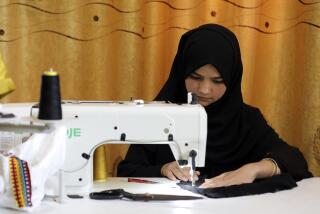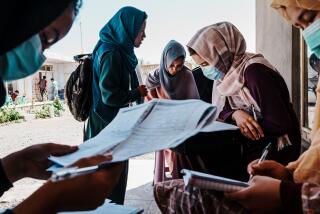Afghan ‘public guards’ plan delayed by disputes
- Share via
KABUL, AFGHANISTAN — In village after village, the pattern is the same. Sinister “night letters” threaten tribal elders considered loyal to the government. The local girls school is forced to close down -- or goes up in flames. Those bold or reckless enough to travel by road risk ambush, abduction or worse.
Alarmed by the tightening Taliban grip on huge swaths of Afghan countryside, U.S. strategists last year began quietly pushing the idea of using locally recruited tribesmen to protect their villages against an increasingly lethal insurgency.
But since then, this American-backed and Afghan-administered “public guards” initiative has been hit by disputes and delays, clouding prospects for wider success even before a limited pilot program begins.
Proponents say the public guards could provide much-needed backup for thinly deployed Western and Afghan forces -- who, NATO and U.S. commanders say, will remain overstretched even with the arrival this year of as many as 30,000 additional American troops. President Obama has indicated that the Afghan conflict will be a top priority of his new administration.
But Western diplomats and Afghan officials familiar with planning of the public guards program say fundamental disagreements remain over the mission and makeup of the force. The disputes include such basics as whether its members will be armed and by whom, how they will be vetted and who will command them.
The idea of Western forces striking alliances with tribes to fight insurgents gained currency in Iraq, where Sunni Arabs’ Awakening movement was widely credited with bringing about a significant drop in violence. Army Gen. David H. Petraeus, the former Iraq commander who heads the U.S. Central Command and visited Afghanistan this week, is expected to move aggressively to revamp U.S. strategy here.
With confidence in Afghanistan’s central government faltering among Western allies and the Afghan electorate alike, hyper-local initiatives such as the public guards plan are likely to become a more important piece of that puzzle.
“These are people who come from the village, serving the village; come from the tribe, serve the tribe,” William Wood, the U.S. ambassador to Afghanistan, told reporters last month in Kabul, the capital. “We’re trying to strengthen the villages, we’re trying to strengthen the tribes. That’s the goal.”
The timing, though, remains unclear. An inaugural effort was to have been launched already in Wardak, a violence-plagued province on Kabul’s doorstep, as a prelude to setting up similar micro-militias in the country’s south and east. But Afghanistan’s Interior Ministry, which will oversee the public guards program, has several times postponed its rollout.
“We really cannot say at this time what is happening with that,” ministry spokesman Zemari Bashary said.
To critics, the initiative risks putting the government’s imprimatur on groups whose main interest might lie in settling scores rather than confronting the Taliban. There is deep mistrust here of tribal militias, which historically have engaged in bloody clan vendettas.
For many Afghans, the notion of private militias also evokes nightmarish memories of urban battles between warlords in the early 1990s. Entire districts of the capital, still rocket-pocked and battered, serve as a testament to that spasm of factional fighting that helped set the stage for the rise of the Taliban.
Critics also point to a disastrous 2006 effort by the government of Afghan President Hamid Karzai to create an auxiliary force to supplement the regular police. With little or no screening of recruits, large numbers promptly deserted to join the insurgency, taking their government-issued weapons with them.
“We need to protect our country with our police and army, not a bunch of uneducated guys running around with guns,” said Khan Mohammed, a businessman in the southern city of Kandahar. “One trained soldier or policeman is better than 10 or even 50 militiamen, because they won’t follow any rules.”
But to authorities in places like Wardak, where long stretches of the main national highway are littered with the remains of bombed-out convoys and government control is tenuous everywhere except district centers, the idea seems worth trying.
“We need something to fill the gap; there aren’t enough police and there aren’t enough troops,” said Mohammed Halim Fidai, Wardak’s governor. “Who is more motivated than someone guarding his home and family?”
The conflicting terminology used by the program’s backers suggests that their rival visions will be difficult to reconcile.
“We are not talking here about creating tribal militias,” said Army Col. Gregory Julian, a spokesman for U.S. forces in Afghanistan. U.S. and North Atlantic Treaty Organization commanders instead liken the program to a “neighborhood watch” -- albeit one more anxious about beheadings and school burnings than burglary.
Many of the plan’s Afghan backers say, however, that they expect the public guards to be modeled on traditional tribal groups called arbakais -- in no small measure because in rural Afghanistan almost everything breaks down along tribal lines.
Some Afghan officials worry tribal leaders’ main goal in supporting the initiative is to expand influence, particularly because money to pay guards will be funneled through tribal councils, which are also supposed to vouch for those picked to serve as “paid volunteers.”
Another sensitive point is weaponry. If the public guards are given guns, as expected, it would fly in the face of years of efforts by the Afghan government to disarm private militias. But few believe village-based groups would dare confront the Taliban, even indirectly, unless they have ready access to weapons.
U.S. and NATO officials said they did not envision arming the public guards. But one American military official acknowledged that nearly every village home has weapons, and use of them might be tacitly allowed.
Critics consider that hypocritical.
“It’s a bad plan -- why did the international community insist that we get rid of illegal weapons and then turn around and do this?” said Haji Ahsan Noor, a member of the Kandahar provincial council.
Villagers themselves are torn between the desire for protection and fear that these local guards might aggravate the danger. Many in Wardak are waiting to see whether the presence of 3,200 troops from the U.S. Army’s 10th Mountain Division, who this month are deploying there and to nearby Lowgar province, will force the insurgents to pull back.
“What I’m afraid of is making things worse,” said a village schoolteacher in Wardak who spoke on condition of anonymity because she feared drawing attention to herself or her school. “Why not wait and see how things go here with more Americans, instead of saying that we will keep out the Taliban ourselves? We can’t.”
--
More to Read
Sign up for Essential California
The most important California stories and recommendations in your inbox every morning.
You may occasionally receive promotional content from the Los Angeles Times.













